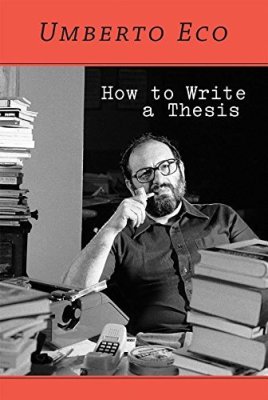The MIT Press. 2015. 461 pages. ISBN: 0262527138
В оригинале по-итальянски книга называется «Как написать дипломную
работу в области гуманитарных наук». Книга выдержала двадцать три
издания в Италии и была переведена на семнадцать языков. Русский
перевод здесь: /file/515288/
By the time Umberto Eco published his best-selling novel The Name
of the Rose, he was one of Italy's most celebrated intellectuals, a
distinguished academic and the author of influential works on
semiotics. Some years before that, in 1977, Eco published a little
book for his students, How to Write a Thesis, in which he offered
useful advice on all the steps involved in researching and writing
a thesis - from choosing a topic to organizing a work schedule to
writing the final draft. Now in its twenty-third edition in Italy
and translated into seventeen languages, How to Write a Thesis has
become a classic. Remarkably, this is its first, long overdue
publication in English.
Eco's approach is anything but dry and academic. He not only offers
practical advice but also considers larger questions about the
value of the thesis-writing exercise. How to Write a Thesis is
unlike any other writing manual. It reads like a novel. It is
opinionated. It is frequently irreverent, sometimes polemical, and
often hilarious. Eco advises students how to avoid "thesis
neurosis" and he answers the important question "Must You Read
Books?" He reminds students "You are not Proust" and "Write
everything that comes into your head, but only in the first draft."
Of course, there was no Inteet in 1977, but Eco's index card
research system offers important lessons about critical thinking
and information curating for students of today who may be burdened
by Big Data.
How to Write a Thesis belongs on the bookshelves of students,
teachers, writers, and Eco fans everywhere. Already a classic, it
would fit nicely between two other classics: Strunk and White and
The Name of the Rose.
Eco Umberto. How to Write a Thesis
- формат epub
- размер 2,38 МБ
- добавлен 09 марта 2015 г.

Похожие разделы
- Академическая и специальная литература
- Лесное дело и деревообработка
- Лесоведение и лесоводство
- Лесоводство
- Лесоводство: курсовое и дипломное проектирование
- Академическая и специальная литература
- Машиностроение и металлообработка
- Основы технологии машиностроения
- Курсовое и дипломное проектирование
- Академическая и специальная литература
- Междисциплинарные материалы
- Основы исследовательской деятельности
- Диссертационная работа: методика подготовки и защиты
